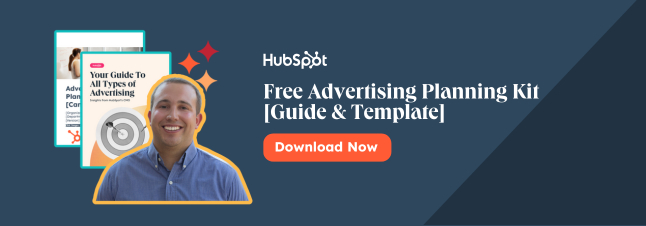- Like
- SHARE
- Digg
- Del
- Tumblr
- VKontakte
- Flattr
- Buffer
- Love This
- Save
- Odnoklassniki
- Meneame
- Blogger
- Amazon
- Yahoo Mail
- Gmail
- AOL
- Newsvine
- HackerNews
- Evernote
- MySpace
- Mail.ru
- Viadeo
- Line
- Comments
- Yummly
- SMS
- Viber
- Telegram
- JOIN
- Skype
- Facebook Messenger
- Kakao
- LiveJournal
- Yammer
- Edgar
- Fintel
- Mix
- Instapaper
- Copy Link
Remember when you’d go to the mall, see something you liked, but then leave without it? Then you’d leave the mall and think about it the whole drive home, wondering if you made the right decision until you forgot about it. That was until you saw someone else with the exact item we wanted. Ah, the good ol’ days.
Today, you can’t leave an item in your cart without it following you everywhere online. Who do we have to thank for that? Technically, a lot of people – marketers, retargeting tools, Al Gore’s internet – but for the purpose of this article, we’ll focus on one: dynamic ads.
Dynamic ads allow brands to change the ads shown to users based on their behavior.
Let’s dive into what exactly dynamic ads are, their benefits, and how to use them on social media platforms like LinkedIn and Facebook.
What are dynamic ads?
Dynamic ads, also called dynamic banner ads or dynamic creatives, are ads in which the content, promotions, and calls-to-action change based on user behavior. They help marketers deliver more relevant ads that connect with their target audiences.
Dynamic ads are often used in remarketing campaigns to reach users who have already interacted with a brand. More on that here.
Static ads, on the other hand, do not adapt based on external data, so they tend to target broader audience groups for brand awareness or product launches.
A banner ad can look like this:
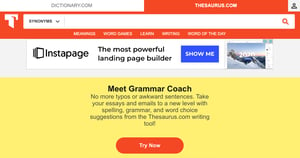 Or like this:
Or like this:
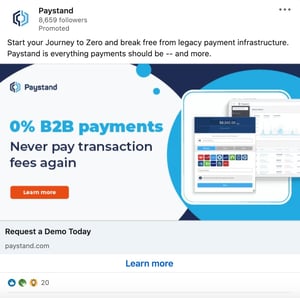
They range in size and placement depending on the platform on which they’re displayed.
The Benefits of Dynamic Ads
Ad personalization is one of the biggest advantages of using dynamic banner ads. In a 2020 study by Innovid, 43% of respondents agreed that ads should be personalized.
What’s more, 30% of respondents said they liked brands more when ads were personalized. It’s easy to understand why – there’s nothing more annoying than getting an irrelevant ad that doesn’t relate to you or your interests. In fact, it’s a major reason why people get adblockers.
In 2020, AudienceProjects surveyed people in the US, UK, Denmark, Sweden, Norway, and Finland and found that avoiding offensive or irrelevant ads was the second most popular reason why they got adblockers.
The more personalized the ad, the better the chances it will resonate with the audience. This brings us to the next benefit of dynamic ads: relevance.
While an ad may be personalized, it may not be relevant to that user’s current stage in the buyer’s journey.
For instance, imagine you’ve heard of a brand but aren’t exactly sure what they do or what they offer. Getting an ad to request a product demo may be too big of a jump. You may need more nurturing before you reach that level of interest in their products.
With this in mind, dynamic ads can help you only present ads that will meet the user where they are. Doing so can move them further down the funnel and help generate more revenue for your brand.
This brings us to return on investment (ROI). Because of the reasons outlined above, your dynamic ads can optimize your return on ad spend (ROAS) because they are more targeted and relevant to each user.
How Dynamic Search Ads Work
What are dynamic search ads?
Dynamic search ads (DSAs) are dynamic ads that show up on search engines like Google and Bing based on the content of your website, not keywords.
When marketers set up search campaigns, they bid on specific keywords and create ads that match the intent behind the keywords. For instance, let’s say you’re a website operations company and you want to rank for the keyword “best WebOps platforms,” you’ll need to bid on it and win to show up on the search engine when a user searches that keyword.
With dynamic search ads, you don’t have to bid on the keywords. The search engine will analyze the user’s search query and scan your website for relevant content. If the search engine determines it’s a match for what the user is looking for, it will automatically generate the ad with a headline and text based on a relevant landing page from your website.
The main benefit of using DSAs is that it allows marketers to target audiences who may fall outside of the keywords they’re already targeting in their campaign.
Think of a dynamic search as a safety net; even a well-designed search campaign won’t target all of the keywords your user persona might search for. The dynamic ad identifies new targeting opportunities and fills that gap by aligning your content with the right users – earning you extra traffic and more reach.
It’s also a time-saver. With dynamic ads, you don’t have to go through the process of mapping out keywords, setting up bids, and creating copy for every single ad.
What are dynamic display ads?
Dynamic display ads are banner ads that change on the websites they’re shown based on user behavior.
My latest browsing sessions have involved a lot of furniture and home decor websites. This is why my Facebook feed includes ads like this:
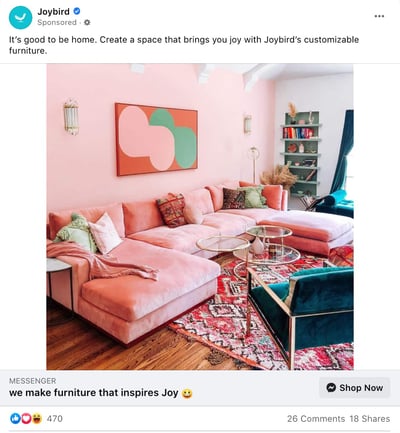 And why I see ads like this when browsing online.
And why I see ads like this when browsing online.
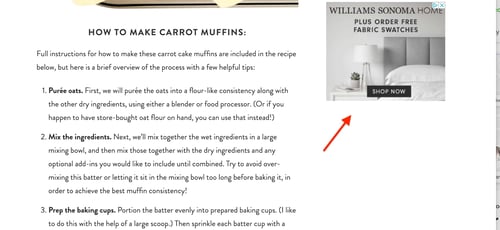 They work just as regular dynamic ads do, adapting their content to the user for better results.
They work just as regular dynamic ads do, adapting their content to the user for better results.
You can take your display ads one step further by creating responsive dynamic display ads. It’s a mouthful, I know but the concept is simple to understand: A responsive ad adjusts its size based on the space on the page.
For example, you’re on a website and you minimize the page to make space for another window. A responsive ad would adapt its shape based on that new space – just like a responsive website.
This creates a better user experience and ensures your ad will be displayed correctly no matter the screen size.
Dynamic Remarketing Ads
Let’s say I visit the Sabai Design website to look at furniture. Then, I put a beautiful emerald green couch in my cart but don’t complete the purchase.
If the brand sets up dynamic remarketing ads, I’d see that couch, and similar styles, as I’m scrolling through social media or browsing through websites over the next few days or weeks.
The way dynamic remarketing works is by pulling the product feed from your website and leveraging user data to show your visitors ads that will move them down your funnel.
You can target various ad groups, ranging from visitors who’ve only visited your product pages to those who have already purchased items from you.
Then, once you generate the ad copy and the offers, the ad platform you use will do the rest. This means pulling the relevant product information to show that specific user.
LinkedIn Dynamic Ads
When creating a dynamic ad on LinkedIn, you will target users based on their profile, including demographics such as location, work experience, company, and job title.
There are three main formats to use when creating ads on the professional network:
Follower Ads
 If you want to gain more followers on your LinkedIn Company Page, create a Follower Ad. This will encourage users in your ad group to follow your Page and learn more about your brand.
If you want to gain more followers on your LinkedIn Company Page, create a Follower Ad. This will encourage users in your ad group to follow your Page and learn more about your brand.
Spotlight Ads
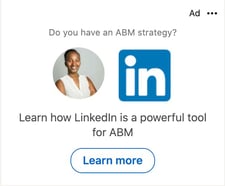
Want to drive traffic to your website or landing page? Use a spotlight ad. You can also use it to promote upcoming events, highlight your products or services, or gain new email subscribers.
Content Ads
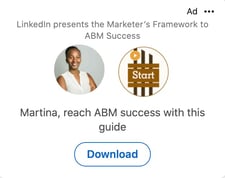 Content offers are great lead magnets. This dynamic ad format allows you to generate leads through downloadable offers. You can manage those leads in the LinkedIn Campaign Manager or export them to a CRM like the HubSpot Marketing Hub’s Ads Software.
Content offers are great lead magnets. This dynamic ad format allows you to generate leads through downloadable offers. You can manage those leads in the LinkedIn Campaign Manager or export them to a CRM like the HubSpot Marketing Hub’s Ads Software.
You’ll notice that none of these ads show up as a carousel image, single image ad, video, or text ad. That’s because dynamic ads on LinkedIn are only formatted to show up on the right sidebar on desktop view. Like this:
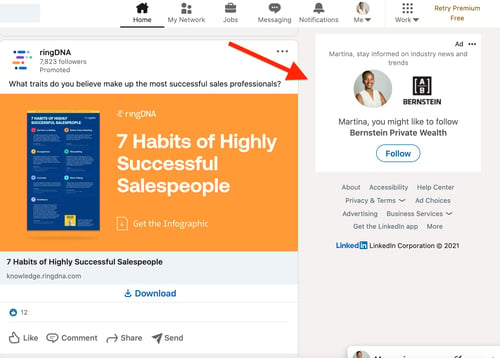
Facebook Dynamic Ads
On Facebook, things work a little differently. In this case, dynamic ads are ideal for brands with a large inventory of products and/or services. Unlike LinkedIn ads, when creating a dynamic ad on Facebook, you can choose any ad format, including single image, carousel, stories, or collection.
Here’s how Facebook dynamic ads work: You can create a retargeting campaign to reach consumers who’ve had previous interactions with your brand, or reach a broader audience that matches your user persona and may be interested in your products or services.
To set up a dynamic ad on Facebook, you’ll need:
- A catalog – This contains the products and services you want to promote, with descriptions, prices, images, availability, and other relevant information.
- Facebook pixel or DSK – You must install a Facebook pixel on your website or SDK for your mobile app to capture how your users are behaving on your webpages or app.
From there, you will set up your campaign in the Ads Manager to outline your ad objectives, ad format, copy, and calls-to-action (CTA) by product set.
Every time a user fits your targeting parameters, the machine learning program will use the pixel to gather user data and pick relevant products or services from your catalog to display the ad on mobile, tablet, or desktop.
This saves marketers time, as they don’t have to create an ad for every single product or ad group.
You may no longer need those drives home from the mall to decide if you really should have bought something. With dynamic ads, you get multiple chances to reconsider your decisions.
Whether that’s a good thing varies from person to person, but from a marketing standpoint, it’s another opportunity to win over a consumer. Why not take it?
Originally published Apr 6, 2021 7:00:00 AM, updated April 06 2021


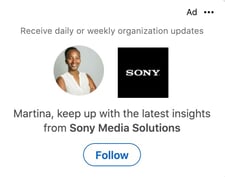 If you want to gain more followers on your LinkedIn Company Page, create a Follower Ad. This will encourage users in your ad group to follow your Page and learn more about your brand.
If you want to gain more followers on your LinkedIn Company Page, create a Follower Ad. This will encourage users in your ad group to follow your Page and learn more about your brand.